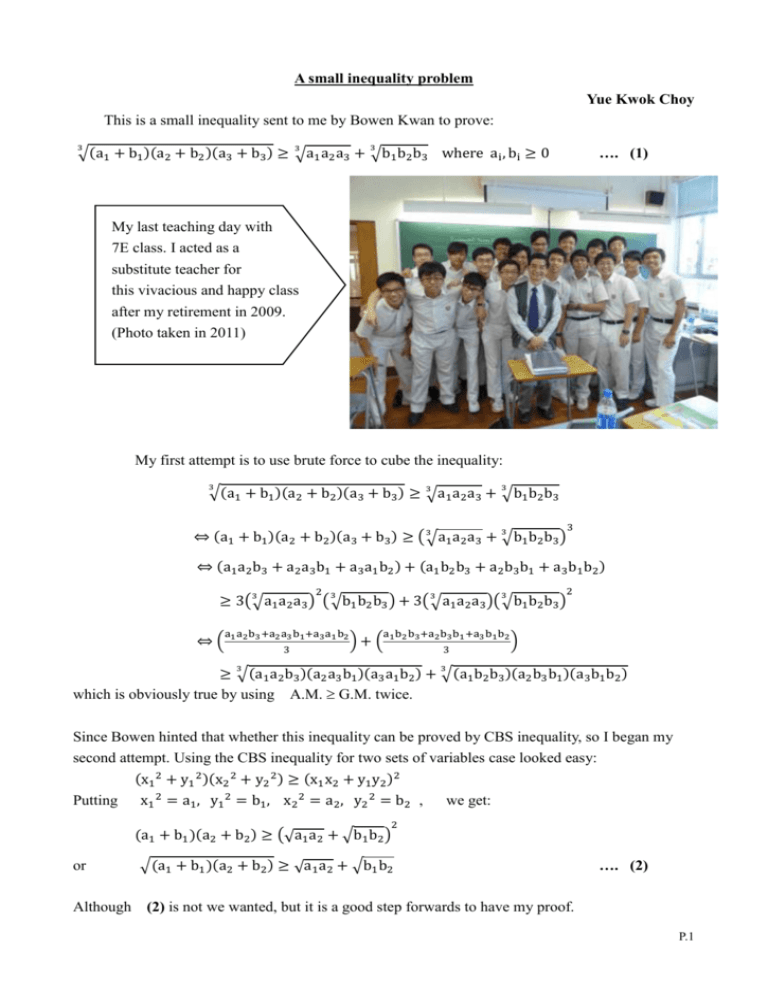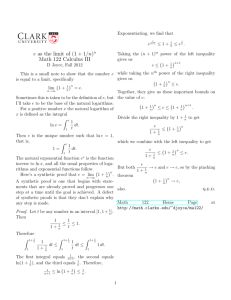A small inequality problem, docx
advertisement

A small inequality problem Yue Kwok Choy This is a small inequality sent to me by Bowen Kwan to prove: 3 √(a1 + b1 )(a2 + b2 )(a3 + b3 ) ≥ 3√a1 a2 a3 + 3√b1 b2 b3 where ai , bi ≥ 0 …. (1) My last teaching day with 7E class. I acted as a substitute teacher for this vivacious and happy class after my retirement in 2009. (Photo taken in 2011) My first attempt is to use brute force to cube the inequality: 3 √(a1 + b1 )(a2 + b2 )(a3 + b3 ) ≥ 3√a1 a2 a3 + 3√b1 b2 b3 3 ⇔ (a1 + b1 )(a2 + b2 )(a3 + b3 ) ≥ ( 3√a1 a2 a3 + √b1 b2 b3 ) 3 ⇔ (a1 a2 b3 + a2 a3 b1 + a3 a1 b2 ) + (a1 b2 b3 + a2 b3 b1 + a3 b1 b2 ) 2 ≥ 3( 3√a1 a2 a3 ) ( 3√b1 b2 b3 ) + 3( 3√a1 a2 a3 )( 3√b1 b2 b3 ) a1 a2 b3 +a2 a3 b1 +a3 a1 b2 ⇔( 3 a1 b2 b3 +a2 b3 b1 +a3 b1 b2 )+( 3 2 ) 3 3 ≥ √(a1 a2 b3 )(a2 a3 b1 )(a3 a1 b2 ) + √(a1 b2 b3 )(a2 b3 b1 )(a3 b1 b2 ) which is obviously true by using A.M. G.M. twice. Since Bowen hinted that whether this inequality can be proved by CBS inequality, so I began my second attempt. Using the CBS inequality for two sets of variables case looked easy: (x1 2 + y1 2 )(x2 2 + y2 2 ) ≥ (x1 x2 + y1 y2 )2 Putting x1 2 = a1 , y1 2 = b1 , x2 2 = a2 , y2 2 = b2 , (a1 + b1 )(a2 + b2 ) ≥ (√a1 a2 + √b1 b2 ) or Although we get: 2 √(a1 + b1 )(a2 + b2 ) ≥ √a1 a2 + √b1 b2 …. (2) (2) is not we wanted, but it is a good step forwards to have my proof. P.1 Applying the C.B.S. inequality directly is not fruitful for proving (1), the reader may try. It is lucky that we can extend to 4 sets of variables case: 4 √(a1 + b1 )(a2 + b2 )(a3 + b3 )(a4 + b4 ) = √√(a1 + b1 )(a2 + b2 )√(a3 + b3 )(a4 + b4 ) ≥ √(√a1 a2 + √b1 b2 )(√a3 a4 + √b3 b4 ) ≥ √√a1 a2 √a3 a4+√√b1 b2 √b3 b4 = 4√a1 a2 a3 a4 + 4√b1 b2 b3 b4 …. (3) To get back to (1), we need to put away a4 , b4 . 3 a4 = 3√a1 a2 a3 , b4 = √b1 b2 b3 We let and substitute in (3) . 4 √(a1 + b1 )(a2 + b2 )(a3 + b3 )(a4 + b4 ) ≥ 4√a1 a2 a3 a4 + 4√b1 b2 b3 b4 4 4 4 √(a1 + b1 )(a2 + b2 )(a3 + b3 )( 3√a1 a2 a3 + 3√b1 b2 b3 ) ≥ √a1 a2 a3 3√a1 a2 a3 + √b1 b2 b3 3√b1 b2 b3 4 4 √(a1 + b1 )(a2 + b2 )(a3 + b3 ) √( 3√a1 a2 a3 + 3√b1 b2 b3 ) ≥ ( 3√a1 a2 a3 + 3√b1 b2 b3 ) 4 4 3 √(a1 + b1 )(a2 + b2 )(a3 + b3 ) ≥ √( 3√a1 a2 a3 + √b1 b2 b3 ) 3 3 √(a1 + b1 )(a2 + b2 )(a3 + b3 ) ≥ 3√a1 a2 a3 + 3√b1 b2 b3 Using CBS inequality to prove (1) is obviously tedious, but it can give a nice extension of this inequality as we shall see. My third attempt to deal with (1) is given below. I use “think backwards, write forwards” and the reader may trace my way of thinking by beginning at the last line and read backwards. By A.M. G.M., a1 a2 a3 b1 b2 b3 + + + + a1 + b1 a 2 + b2 a 3 + b3 a1 + b1 a 2 + b2 a 3 + b3 + 3 3 3 ≥√ 3 ⇔1≥ 3 a1 a2 a3 b1 b2 b3 +√ a1 + b1 a 2 + b2 a 3 + b3 a1 + b1 a 2 + b2 a 3 + b3 3 √a1 a2 a3 + √b1 b2 b3 3 √(a1 +b1 )(a2 +b2 )(a3 +b3 ) 3 ⇔ √(a1 + b1 )(a2 + b2 )(a3 + b3 ) ≥ 3√a1 a2 a3 + 3√b1 b2 b3 Nice, short, isn’t it? P.2 Last, but not the least, I try to give (1) a possible extension. By studying (1), (2) and (3), we can get: n n n n n ∏(ai + bi ) ≥ √∏ ai + √∏ bi i=1 Two possible proofs of i=1 … . (𝟒) i=1 (4) are : (a) Use “Backward mathematical induction”. (a very long proof) (b) Use my “third attempt”. (a very short proof) I leave the proofs for the reader as an exercise. For those who don’t know much on backward induction may find my example useful: http://www.qc.edu.hk/math/Resource/AL/AGM_1.pdf P.3







